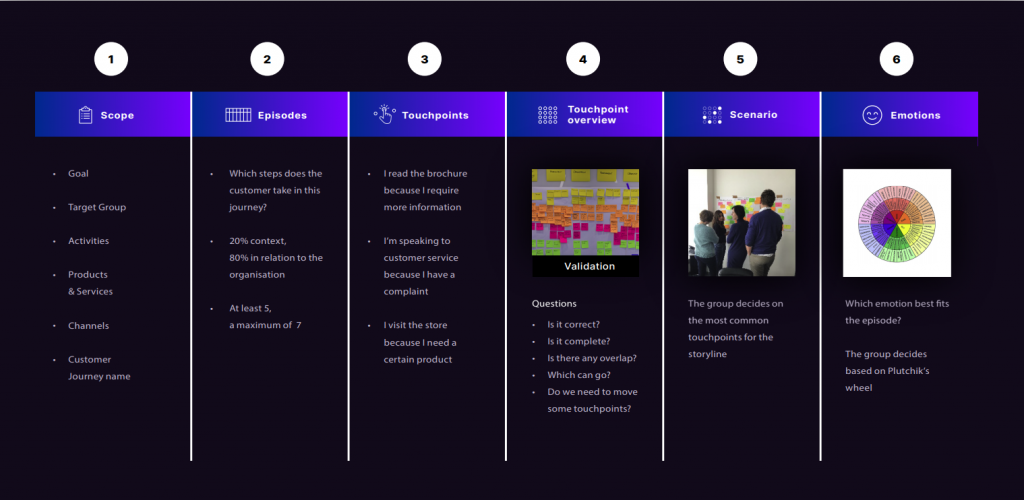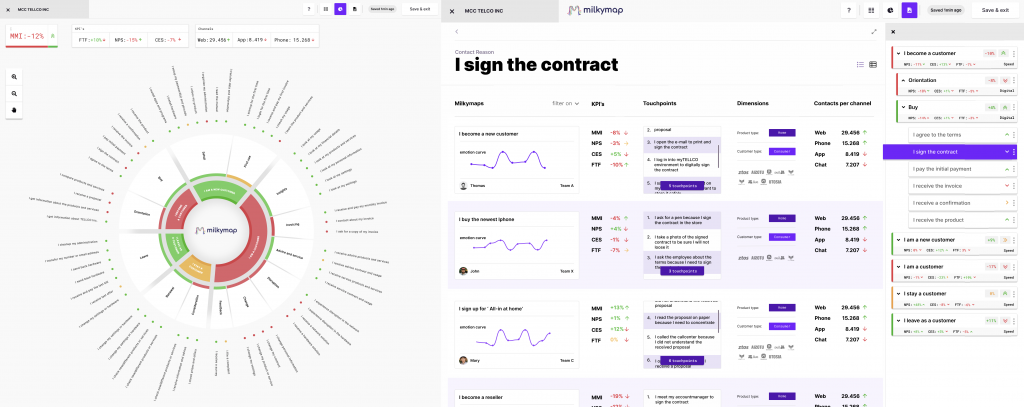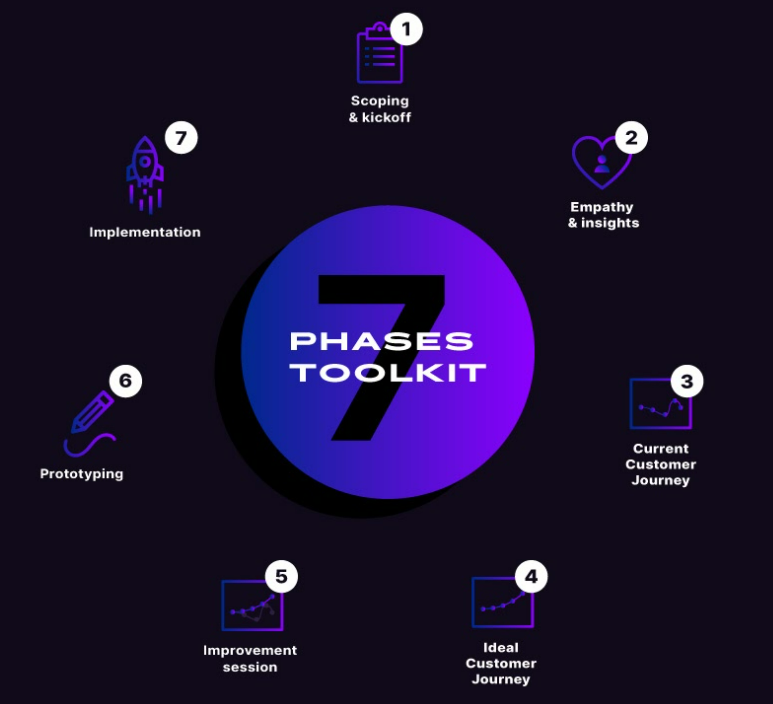When an organisation starts visualizing Customer Journeys, or they develop in the field of Customer Journey Mapping, certain obstacles will arise. It’s important to identify and solve these issues early, as it will allow you and your organisation to work on improving Customer Experience. In this article, we’ll discuss solutions for several common Customer Journey Mapping problems.

Problems when Customer Journey Mapping and their solutions
In 2020 we spoke to dozens of Customer Experience experts. We asked them what problems they and their organisations run into to improve Customer Experience and achieve related objectives. We mainly did this in (online) one-on-one meetings and during several webinars.
1. Organisations often visualize Customer Journey Maps in different platforms/programs and formats. A standardized methodology that is managed by the organisation is missing.
Ensure that there is one way of visualizing in the entire organisation. Use the same terminology, definitions, and method when creating Customer Journey Maps. This way, maps are easily compared and will provide more insights.
Milkymap’s 6 step methodology is a simple and practical way to visualize Customer Journeys in a standardized way. Once the methodology has been adopted by Customer Journey owners in your organisation, you will have more uniform and comparable journey maps.

2. Visualizations of Customer Journey Maps are kept in different locations. Not everyone can access them, or they become inaccessible when someone changes positions or leaves the organisation.
Manage all Customer Journey Maps in one environment. This ensures they are accessible, easy to share, and can be managed by others if necessary. There are multiple options for this, such as saving them in Google Drive, Dropbox, or directly in a Customer Journey Mapping platform where you’re also able to visualize Customer Journeys.
3. Multiple people are responsible for sharing and managing a Customer Journey. This makes it hard to identify the source of positive or negative contributions.
Appoint one owner for each Customer Journey. When a journey has one owner, it becomes easier for the entire organisation to manage each Customer Journey, maintain an accurate overview, and efficiently work on improving Customer Experience.
4. Keeping track of different versions of Customer Journey Maps is hard. An Excel file or PowerPoint presentation often contains only an image of a Customer Journey and not a (near) real-time overview of the Customer Experience. When a Customer Journey Map is sent via email, it can become outdated very quickly.
The solution to this problem is connected to the first two issues. By uniformly visualizing Customer Journey Maps and organizing them in one location, keeping track of different versions becomes easier. Using a Customer Journey Mapping platform where you can both visualize and share Customer Journey maps will eliminate the struggles of keeping up with different versions. Making adjustments can be done quickly and more effectively, ensuring you have an up-to-date overview of your Customer Experience.
In Milkymap, you can share Customer Journey Maps, comment on them and show them to others in presentation view as well.
5. Comparing Customer Journeys is difficult because they have different KPIs (CX metrics) included in them that are oftentimes measured in different ways. This makes it hard to know how a certain Customer Journey performs.
Determine which CX metrics should be included in each journey and how they will be measured. Like this, you’ll be able to measure them uniformly, for example using NPS, CSAT, or CES. It’s also important to identify the level you’ll be measuring the metrics on within the Customer Journey, for example at Touchpoint, Episode, or overall journey level. You could also decide to measure a specific dimension, like a customer segment, brand, or channel. It will be determined by the number of customers available to survey, the depth of analysis that’s required, and the budget available.
In the Milkymap platform, you can add metrics at different levels, both in a Customer Journey and within the CX Life Cycle Model®. Select metrics you’d like to include and the level you want to measure them in. This ensures you can make the right comparisons after that will provide you with the insights you need. With the data connector in the CX Life Cycle Model®, you can combine customer data from different systems in the CX Actionboard.
From the Life Cycle Model, you can click through to different dimensions, Customer Journeys, and channels. It provides actionable insights because data is being combined from different levels and perspectives. From both a strategic and a practical standpoint, you can check the state of Customer Experience, CX metrics, and related targets daily, weekly, or monthly.

6. Clear definitions are lacking, making analysis and decision making more difficult. It can spark discussions on the meanings of different terms, which can take up a lot of time. Even terms like ‘customer’, ‘channel’ or ‘Touchpoint’. The differences in measurement and measurement level for different metrics also make analysis and decision-making harder.
By implementing a standardized Customer Journey Mapping methodology in your organisation, you can prevent these discussions. With a standardized method, you’ll ensure definitions are clear and straightforward for everyone. Also take some time to determine the right CX metrics for your organisation and the level you’ll measure them on. Both of these conversations are essential for good Customer Journey Management.
7. Something that happens in one Customer Journey, like changing an address, also happens in another Customer Journey. Something that often isn’t visible, because collaboration is lacking. Because the overlap between Customer Journeys hasn’t been identified, initiatives can inadvertently have a positive or negative impact.
Uniform, Customer Journey Maps organized in a platform can also have a positive impact on this issue. They simplify conversations about Customer Journeys and make collaboration easier. Having more conversations from a customer’s perspective can also increase the level of understanding and involvement with employees. To stimulate this, however, different journey owners and teams need to plan some conversations regarding Customer Experience.
Milkymap’s CX Life Cycle Model® makes it easier to identify connections between Customer Journey Maps by connecting them based on Contact Reasons maakt het makkelijker om connecties tussen Customer Journey Maps te zien door ze te verbinden op basis van Contact Reasons. These reasons to be in contact with the organisation are represented in Customer Journeys in touchpoints, with a channel and a specific reason. For example: ‘I visit the website to ‘change my address’, in which the channel is ‘website’ and the Contact Reason is ‘changing my address’. Any overlapping information between different journeys and levels is easily identified this way. You can make a targeted positive impact for your customer by looking at different dimensions of Customer Experience through a single model.
8. Large organisations often have different brands, multiple customer segments, multiple products, and many different channels. Comparing and holistically managing Customer Experience across all these dimensions is hard because there aren’t clear definitions and Customer Journeys aren’t being shared and linked as much as they should.
By organizing Customer Journeys in one location, uniformly, and applying one standardized methodology, it’s easier to maintain an overview of Customer Journey Maps.
With the CX Life Cycle Model®, it is possible to build a complete overview, where you include dimensions. A holistic framework based on Contact Reasons in Phases and Stages, which allows you to zoom in on specific dimensions. This will facilitate conversations about different brands, customer segments, and products.
9. Mapping Customer Journeys doesn’t always have a clear goal. This can be lowering goals, preventing churn, increasing loyalty, or increasing customer satisfaction, or a combination of these.
Set clear goals before you start mapping a Customer Journey. Why do you want to tackle this Customer Journey? What is the added value and what are the insights you’re hoping to gain?
In Milkymap’s 7-phase toolkit, this can be done in the scoping. In this step, you’ll clearly define the journey, including its limits and related objectives.
10. Customer Journeys are often viewed as projects, in which an external organisation is asked to map, analyze and provide insights and improvement ideas. Within an organisation, there can be up to 150 different Customer Journeys. If you view all of these 150 journeys as a project, it becomes unaffordable. In addition to the price, the first Customer Journey project will be years old by the time you reach the 150th journey. An effective and scalable way to keep Customer Journeys relevant, visualize them in a short time frame, and prioritize them based on data, is missing.
When mapping the first, or the first few Customer Journeys, it might be sensible to include an external organisation. This way you can utilize the available knowledge and skills to develop Customer Journey Management in your organisation. We would however advise you to involve a multi-disciplinary team from your own organisation. This increases employee involvement for any improvement ideas that come up during the project, as well as stimulating customer-centric thinking.
The 7-phase toolkit by Milkymap uses Service Design techniques and the Double Diamond framework. This allows an organisation to work on Customer Experience in a structured way. The toolkit can be used by Customer Journey champions in the organisation after finishing a project.

Next Steps
If you or your organisation recognize any of the issues we mentioned, we hope the solutions will help you progress in the area of Customer Journey Mapping and Management. By tackling these problems in time, you make customer-centric working easier within your organisation. This will allow you to make noticeable, positive changes for your customers sooner.
If you or your organisation can use help Customer Journey Mapping, don’t hesitate to get in touch. Milkymap can help you visualize Customer Journeys with our six-step methodology, use our toolkit for a Customer Journey project with a multi-disciplinary team or organize your Customer Journeys by creating a custom CX Life Cycle Model. We’re happy to discuss the options that will allow you to take your next step in Customer Experience.
